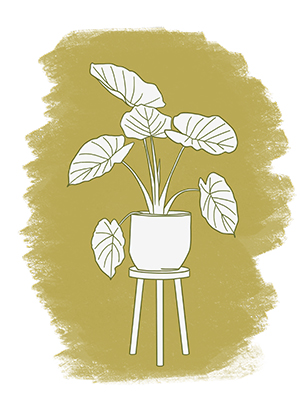Less Stuff by Lindsay Miles
Lindsay Miles on Zero Waste vs Minimalism
7 May 2019 | Cherry Cai
The following extract is from Less Stuff by Lindsay Miles. Less Stuff shows you how to reconcile minimalist living and zero-waste living, and ultimately break the cycle of stuff. While the two concepts may appear to oppose, Lindsay argues that they’re two sides of the same coin. Lindsay is a prominent zero-waste and plastic-free living advocate. She has been sharing ideas and strategies on how to live more meaningful lives with less waste and less stuff on her popular website Treading My Own Path since 2013. Read her thoughts on Zero Waste vs Minimalism below.
To buy Less Stuff, click here.
Zero waste and minimalism sound like opposites. Surely one is about hanging on to stuff and throwing nothing away, and the other is about discarding everything? Despite their seemingly different ideals, they actually have the same philosophy: wasting less. It’s just that they approach it from different angles.
What is zero waste?
Imagine if there was no need for landfill. What if the things we purchased were made well, built to last and designed in such a way that they could be readily repaired, easily repurposed or their materials simply recovered to make new products? Rather than burying the things we no longer need in a hole in the ground for all eternity (or incinerating them into ash and smoke), these items, or the materials they are made from, could become resources for others to use for years to come.
That is the philosophy behind zero waste. If we look at how things work in nature, there is no waste. Nature cycles and recycles everything: air, water, nutrients. Humans are the only species known to create waste.
And what a lot of waste we create! The reality is that many of the things we purchase are not made to last a lifetime, and they aren’t easy to repair if and when they do break. When items are made of mixed materials (such as wood, different types of plastic and different metals) it is not easy to recycle them. It is hard to know what to do with these things other than toss them in the bin.
This isn’t an accident on the part of manufacturers. Many manufacturers deliberately design products to break or wear out. There is even a term for it: planned obsolescence, which means ‘designed for the dump’.
Manufacturers do this to keep us buying their products. There’s a balance they need to find – if things break too easily, we might not go back to their product. If an item lasts forever, they won’t be able to sell us a new one. Products need to last just long enough for us to trust the manufacturer enough to buy a replacement, but expire quickly enough that they can sell us a new product as soon as possible. The old item? That likely ends up in landfill.
Surely things can be done differently? That is where zero waste comes in.
Zero waste is both an industrial design term and a lifestyle philosophy. The term was first coined in the 1970s by a chemist called Dr Paul Palmer, who noticed that companies in Silicon Valley were discarding chemicals that were still perfectly usable. He set up a company (Zero Waste Systems Inc.) to find uses for and resell all of the chemicals that were being discarded.
Palmer recognised that the best way to avoid waste is for everything to be reused indefinitely, and this can only be achieved if reuse is designed into products, rather than only being considered once a product reaches the end of its useful life. He saw zero waste as a design principle.
Most of us are not product designers. We are people who buy things in good faith, and only realise that these things are not durable or fixable or recyclable once they break or wear out, and we are faced with putting them in the bin. But we still have the power to make a difference through our everyday choices and the purchases we make. This is what the zero-waste lifestyle is all about: how individuals can reduce the rubbish they create at home.
The zero-waste lifestyle movement started in 2008, when Bea Johnson began her blog, Zero Waste Home, detailing how her family avoided throwing anything in their bin. Instead, they focused on refusing things they did not need, reducing and reusing – with recycling as the last resort. Today there are thousands of people doing what they can to limit what they put in the bin.
Designing products that can be reused in perpetuity and not throwing anything in the bin might sound fantastic, but is it realistic? Well, it is true that zero waste in its purest form doesn’t actually exist. Not yet. That’s why zero waste is often described as a set of guiding principles, a goal, or a philosophy. We might not be able to achieve perfection, but we can still do what we can with what we have. We can make better choices, not just with our purchases in the future, but also with how we dispose of the things that we own now.
Sending nothing to landfill doesn’t mean simply storing stuff that’s broken, irreparable and useless in our homes instead of putting it in the rubbish bin; it doesn’t mean making our living spaces a pseudo-landfill. It’s about choosing to use resources wisely.
Zero-waste living means:
- refusing products and packaging that are single-use or poorly made, flimsy and non-repairable
- reducing our consumption to only what is necessary (‘necessary’ may differ from person to person – it’s a personal choice, of course, and we all have different needs – but it comes down to mindful consumption, not buying stuff simply because it was on sale at a bargain price/looked appealing in the advert/the next-door neighbour has one)
- reusing items we already have, and choosing reusables over single-use items
- repairing items when they break, rather than simply chucking them out in favour of new ones (which is why choosing well-made and easy-to-repair products is important), or repurposing them so that they can continue to be useful • recycling only what cannot be reused, repaired or repurposed
- rotting, or composting, the scraps that cannot be dealt with any other way.
The zero-waste lifestyle follows these and as a result next to nothing is sent to landfill.
What is minimalism?
In a world that teaches us that accumulating stuff is good, that happiness can be found through shopping and that more is better, minimalism is a deliberate decision to slow down, to look at our possessions and our lifestyles. It’s about letting go of the excess, getting rid of the non-essential and focusing on what brings joy and creates meaning in our lives – experiences, connections and people. The things that make us truly happy are not things at all.
Minimalism is about finding freedom from the pursuit of more, and contentment with what we already have … or maybe even a little bit less.

The truth is, this explosion of consumerism hasn’t resulted in a corresponding growth in happiness. In fact, happiness is thought to have peaked in the 1960s. Instead, we’re stressed, we’re time-poor and we’re unhappy … and buying our way out of it hasn’t worked. Our stuff has begun to own us. Plus we’re using up resources at an alarming rate.
Minimalism is not about wasting stuff, and it is definitely not about chucking stuff in the bin to make space to acquire new stuff. It’s not about only owning one hundred items, or never spending any money. It is not about living in a modern home with sleek designer furniture, or living in a shack in the wilderness. Maybe for some minimalists these lifestyle choices do apply, but for many more none of these apply. It is not about following ‘rules’ (except the ones we make ourselves) or pursuing the least amount of things.
Minimalism is simply a journey to ‘enough’, to discovering the right amount of things for us, and letting go of the excess. It is about spending less money on stuff so there’s less debt and more freedom. It’s about spending less time cleaning and tidying and organising (and shopping!) so there’s more time for the stuff that’s really important – spending time with friends and family, hobbies, helping others and getting involved with our local community.
Can you be a zero-waste minimalist?
Zero waste and minimalism: are they really that different? I don’t think so. At the heart of both is the idea of intentional living. Realising what we truly need, making do and choosing well. Being mindful, making conscious choices and living life with purpose. Two sides of the same coin. Of course, you can aspire to one lifestyle but not the other. There are plenty of people passionate about zero waste who are not minimalists, and many minimalists who do not live a zero-waste lifestyle.
You can be zero waste, you can be minimalist, you can be both… and you can be neither. When it comes to labels, some of us love them, and some of us don’t. If you’re a fan of moderation and these labels just seem too extreme for you, don’t use them. This isn’t about striving for perfection. It’s about doing the best we can. You can know you have too much stuff and want to have less, without wanting to call yourself a minimalist. You can be keen to recycle more, and send less to landfill, without wanting to do away with your rubbish bin entirely and be zero waste.
We all have our own version of enough. Find yours. It doesn’t matter what anybody else’s looks like, nor what they call it. This is about you, your stuff, your relationship to your stuff, and how you’re going to change that for the better.

